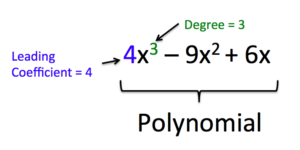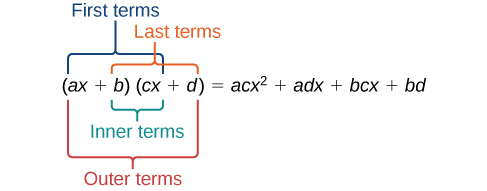Algebraic Operations on Polynomials
Learning Objectives
- Anatomy of a polynomial
- Identify the degree and leading coefficient of a polynomial
- Evaluate a polynomial for given values
- Sums and Products of Polynomials
- Add and subtract polynomials
- Find the product of polynomials
- Find the product of two binomials using the FOIL method
- Multiply a Trinomial and a Binomial
| IS a Polynomial | Is NOT a Polynomial | Because |
| Polynomials only have variables in the numerator | ||
| Polynomials only have variables in the numerator | ||
| Roots are equivalent to rational exponents, and polynomials only have integer exponents |
 A polynomial containing two terms, such as , is called a binomial. A polynomial containing three terms, such as , is called a trinomial.
We can find the degree of a polynomial by identifying the highest power of the variable that occurs in the polynomial. The term with the highest degree is called the leading term because it is usually written first. The coefficient of the leading term is called the leading coefficient. When a polynomial is written so that the powers are descending, we say that it is in standard form. It is important to note that polynomials only have integer exponents.
A polynomial containing two terms, such as , is called a binomial. A polynomial containing three terms, such as , is called a trinomial.
We can find the degree of a polynomial by identifying the highest power of the variable that occurs in the polynomial. The term with the highest degree is called the leading term because it is usually written first. The coefficient of the leading term is called the leading coefficient. When a polynomial is written so that the powers are descending, we say that it is in standard form. It is important to note that polynomials only have integer exponents.

Given a polynomial expression, identify the degree and leading coefficient.
- Find the highest power of x to determine the degree.
- Identify the term containing the highest power of x to find the leading term.
- Identify the coefficient of the leading term.
Example
For the following polynomials, identify the degree, the leading term, and the leading coefficient.Answer:
- The highest power of x is 3, so the degree is 3. The leading term is the term containing that degree, . The leading coefficient is the coefficient of that term, .
- The highest power of t is , so the degree is . The leading term is the term containing that degree, . The leading coefficient is the coefficient of that term, .
- The highest power of p is , so the degree is . The leading term is the term containing that degree, , The leading coefficient is the coefficient of that term, .
| Monomials | Binomials | Trinomials | Other Polynomials |
| 15 | |||
Evaluate a polynomial
You can evaluate polynomials just as you have been evaluating expressions all along. To evaluate an expression for a value of the variable, you substitute the value for the variable every time it appears. Then use the order of operations to find the resulting value for the expression.Example
Evaluate for .Answer: Substitute for each x in the polynomial.
Following the order of operations, evaluate exponents first.
Multiply 3 times 1, and then multiply times .
Change the subtraction to addition of the opposite.
Find the sum.
Answer
Example
Evaluate for .Answer: Substitute 3 for each p in the polynomial.
Following the order of operations, evaluate exponents first and then multiply.
Add and then subtract to get .
Answer
IN the following video we show more examples of evaluating polynomials for given values of the variable.
https://youtu.be/2EeFrgQP1hMAdd and Subtract Polynomials
We can add and subtract polynomials by combining like terms, which are terms that contain the same variables raised to the same exponents. For example, and are like terms, and can be added to get , but and are not like terms, and therefore cannot be added.Example
Find the sum.
Answer:
Given multiple polynomials, add or subtract them to simplify the expressions.
- Combine like terms.
- Simplify and write in standard form.
Example
Find the difference.
Answer:
Analysis of the Solution
Note that finding the difference between two polynomials is the same as adding the opposite of the second polynomial to the first. In the following video we show more examples of adding and subtracting polynomials. https://youtu.be/jiq3toC7wGMMultiplying Polynomials
Multiplying polynomials is a bit more challenging than adding and subtracting polynomials. We must use the distributive property to multiply each term in the first polynomial by each term in the second polynomial. We then combine like terms. You may have used the distributive property to help you solve linear equations such as . We can distribute the in to obtain the equivalent expression . When multiplying polynomials, the distributive property allows us to multiply each term of the first polynomial by each term of the second. We then add the products together and combine like terms to simplify. The following video will provide you with examples of using the distributive property to find the product of monomials and polynomials. https://youtu.be/bwTmApTV_8o Below is a summary of the steps we used to find the product of two polynomials using the distributive property.How To: Given the multiplication of two polynomials, use the distributive property to simplify the expression.
- Multiply each term of the first polynomial by each term of the second.
- Combine like terms.
- Simplify.
Using FOIL to Multiply Binomials
We can also use a shortcut called the FOIL method when multiplying binomials. It is called FOIL because we multiply the first terms, the outer terms, the inner terms, and then the last terms of each binomial. The FOIL method arises out of the distributive property. We are simply multiplying each term of the first binomial by each term of the second binomial, and then combining like terms.
The FOIL method arises out of the distributive property. We are simply multiplying each term of the first binomial by each term of the second binomial, and then combining like terms.
Example
Use FOIL to find the product.Answer:
Find the product of the first terms.
 Find the product of the outer terms.
Find the product of the outer terms.
 Find the product of the inner terms.
Find the product of the inner terms.
 Find the product of the last terms.
Find the product of the last terms.

How To: Given two binomials, use FOIL to simplify the expression.
- Multiply the first terms of each binomial.
- Multiply the outer terms of the binomials.
- Multiply the inner terms of the binomials.
- Multiply the last terms of each binomial.
- Add the products.
- Combine like terms and simplify.
Multiply a Trinomial and a Binomial
Another type of polynomial multiplication problem is the product of a binomial and trinomial. Although the FOIL method can not be used since there are more than two terms in a trinomial, you still use the Distributive Property to organize the individual products. Using the distributive property, each term in the binomial must be multiplied by each of the terms in the trinomial. For our first examples, we will show you two ways to organize all of the terms that result from multiplying polynomials with more than two terms. The most important part of the process is finding a way to organize terms.Example
Find the product. .Answer: Distribute the trinomial to each term in the binomial. Use the distributive property to distribute the monomials to each term in the trinomials. Multiply. Group like terms. Combine like terms.
Answer
Example
Multiply.Answer: Set up the problem in a vertical form, and begin by multiplying by . Place the products underneath, as shown. Now multiply by . Notice that ; since this term is like , place it directly beneath it. Finally, multiply by . Notice that is placed underneath . Now add like terms.
Answer
Example
Find the product.Answer:
Analysis of the Solution
Another way to keep track of all the terms involved in this product is to use a table, as shown below. Write one polynomial across the top and the other down the side. For each box in the table, multiply the term for that row by the term for that column. Then add all of the terms together, combine like terms, and simplify. Notice how we kept the sign on each term, for example we are subtracting from , so we place in the table.Example
Multiply.Answer: Distribute 2p and -1 to each term in the trinomial.
Multiply. (Notice that the subtracted 1 and the subtracted 3p have a positive product that is added.)
Combine like terms.
